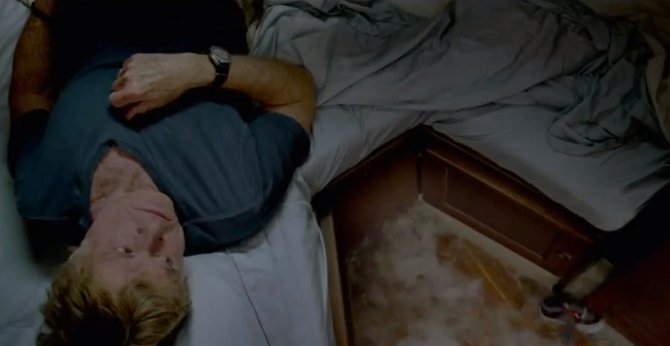 Facebook
Facebook
 X
X
 Instagram
Instagram
 TikTok
TikTok
 Youtube
Youtube

The image above is actually the film's second opening shot. It's the opening of chapter one in the story. What comes before is a prologue.
The prologue opens with a shot of an utterly calm sea at dawn. Tranquility itself, all gentle grays and pinks and even gentler laps and ripples. Quite a contrast with the opening line of the voiceover: "I'm sorry." Uh-oh. Something's wrong.
Viewers of a certain age may remember Robert Redford as one of the great handsome men of cinema. The sun-kissed skin, the wind-tousled hair, the little-boy smile that let you know he couldn’t lose. Like the title says, all is lost. Disaster rouses an solo yachtsman from comfortable sleep: a drifting shipping container has punched a hole in his boat. Skillful efforts at repair and recovery eventually give way to a grueling struggle to simply survive. The sun blisters, the wind ravages, the face twists and sags. The metaphor — we’re all on a journey, people — is kept mostly in the background, but the lack of dialogue and singular focus make it impossible to miss. (Just about the only time writer-director J.C. Chandor takes the camera off Redford is to give us gradually deepening shots from below the life raft: first minnows, then a school of fish, then predators, and finally, sharks.)
The camera pans very slowly to the left, and we find out just what that something is (and also, what that tranquil sea is lapping against): a red steel shipping container. Half-sunk but still afloat, It rises from the water like an artificial iceberg, looming higher and higher as the camera pans across its bulk. Here it is, the very bad thing, the thing that should not be there, the thing we could not anticipate that disturbs our peace and contentment. Here is disaster in the face of all our plans. Here is death in the face of all our pleasures.
That is what leads us to the shot above: Robert Redford, the captain of his own boat and seemingly the master of his own fate, a man of means and skill, woken suddenly from a comfortable sleep by unanticipated, random, nightmarish disaster. Water is pouring into his boat, carrying with it, of all things, a child's shoe. How absurd. And yet, we have already heard him say "I'm sorry" to an unnamed someone whom he has failed. We know that it took the threat of death to make him assess his life and try to make amends. We know already that "all is lost" is what had to happen for something to be found.


The image above is actually the film's second opening shot. It's the opening of chapter one in the story. What comes before is a prologue.
The prologue opens with a shot of an utterly calm sea at dawn. Tranquility itself, all gentle grays and pinks and even gentler laps and ripples. Quite a contrast with the opening line of the voiceover: "I'm sorry." Uh-oh. Something's wrong.
Viewers of a certain age may remember Robert Redford as one of the great handsome men of cinema. The sun-kissed skin, the wind-tousled hair, the little-boy smile that let you know he couldn’t lose. Like the title says, all is lost. Disaster rouses an solo yachtsman from comfortable sleep: a drifting shipping container has punched a hole in his boat. Skillful efforts at repair and recovery eventually give way to a grueling struggle to simply survive. The sun blisters, the wind ravages, the face twists and sags. The metaphor — we’re all on a journey, people — is kept mostly in the background, but the lack of dialogue and singular focus make it impossible to miss. (Just about the only time writer-director J.C. Chandor takes the camera off Redford is to give us gradually deepening shots from below the life raft: first minnows, then a school of fish, then predators, and finally, sharks.)
The camera pans very slowly to the left, and we find out just what that something is (and also, what that tranquil sea is lapping against): a red steel shipping container. Half-sunk but still afloat, It rises from the water like an artificial iceberg, looming higher and higher as the camera pans across its bulk. Here it is, the very bad thing, the thing that should not be there, the thing we could not anticipate that disturbs our peace and contentment. Here is disaster in the face of all our plans. Here is death in the face of all our pleasures.
That is what leads us to the shot above: Robert Redford, the captain of his own boat and seemingly the master of his own fate, a man of means and skill, woken suddenly from a comfortable sleep by unanticipated, random, nightmarish disaster. Water is pouring into his boat, carrying with it, of all things, a child's shoe. How absurd. And yet, we have already heard him say "I'm sorry" to an unnamed someone whom he has failed. We know that it took the threat of death to make him assess his life and try to make amends. We know already that "all is lost" is what had to happen for something to be found.
Comments